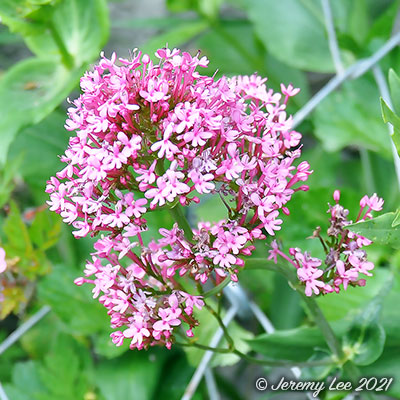
 |
|
Scientific Classifications explained » Amphibians » Ants » Aphids » Bees » Beetles » Birds » Bugs » Butterflies » Caterpillars » Damselflies » Dragonflies » Earwigs » Flies » Frog/Leafhoppers » Fungi » Galls » Grasshoppers » Harvestmen » Hoverflies » Lacewings » Ladybirds » Leaf Mines » Lichens » Mammals » Millipedes » Mosses » Moths » Sawflies » Slugs » Snails » Spiders » Trees » Wasps » Wild Flowers » Woodlice » PB |
UK Nature > Wild Flowers > Red & Pink Wild Flowers > Centranthus ruber

Scientific Name: Centranthus ruber Common Name: Red Valerian Centranthus ruber, more commonly known as Red Valerian (other common names include spur valerian, kiss-me-quick, fox's brush, devil's beard and Jupiter's beard), is a delightful wildflower, bearing grey-green leaves and dense clusters of crimson, pink or white, slightly fragrant flowers from late spring to autumn. It grows as a perennial plant, usually as a subshrub though it can take any form from a herb to a shrub depending on conditions; the plants are usually woody at the base. The leaves are generally 5–8 cm in length. Their form changes from the bottom to the top of the plant, the lower leaves being petiolate while the upper leaves are sessile. The leaves grow in opposite pairs and are oval or lanceolate in shape. The plant flowers profusely, and though the individual flowers are small (no more than 2 mm), the inflorescences are large and showy. The flowers are small in rounded clusters each with 5 fused petals and a spur. The most typical color is a brick red or purplish red, but colors include deep crimson, pale pink, and lavender. They are pollinated by both bees and butterflies and the plant is noted for attracting insects. It is used as a food plant by the larvae of some Lepidoptera species including Angle Shades. Seeds have tufts similar to dandelions that allow wind dispersal, and as such can self-seed freely and become invasive if not properly controlled. |
|

https://www.uknature.co.uk is a website dedicated to showing the immense diversity of UK nature and wildlife. Our vast range of habitats, from lowland arable to snow covered mountains, from storm-ravaged coastlines to peaceful inland freshwater lakes and rivers, from dry, sandy heaths to deciduous and coniferous forests, all these habitats contribute to the abundance of UK nature. We have wild birds in huge numbers either residing or visiting our shores (597 recorded species as at July 2013) and we must also not forget the humble back garden with its grass lawns, flower beds filled with nectar rich flowers, shrubs and trees, all designed to attract huge numbers of insects such as bees, moths, butterflies and hoverflies; and finally the small ponds which provide safe havens for frogs, toads, newts and even slow worms and grass snakes. www.uknature.co.uk is the showcase for my personal passion, photographing uknature in all its glory. I sincerely hope you all enjoy the fruits of my labours. This site and all images contained therein is © Jeremy Lee 2004 - 2025. All Rights Reserved. Site design by Jeremy Lee. Site development & IT Support by Stuart Lee. |